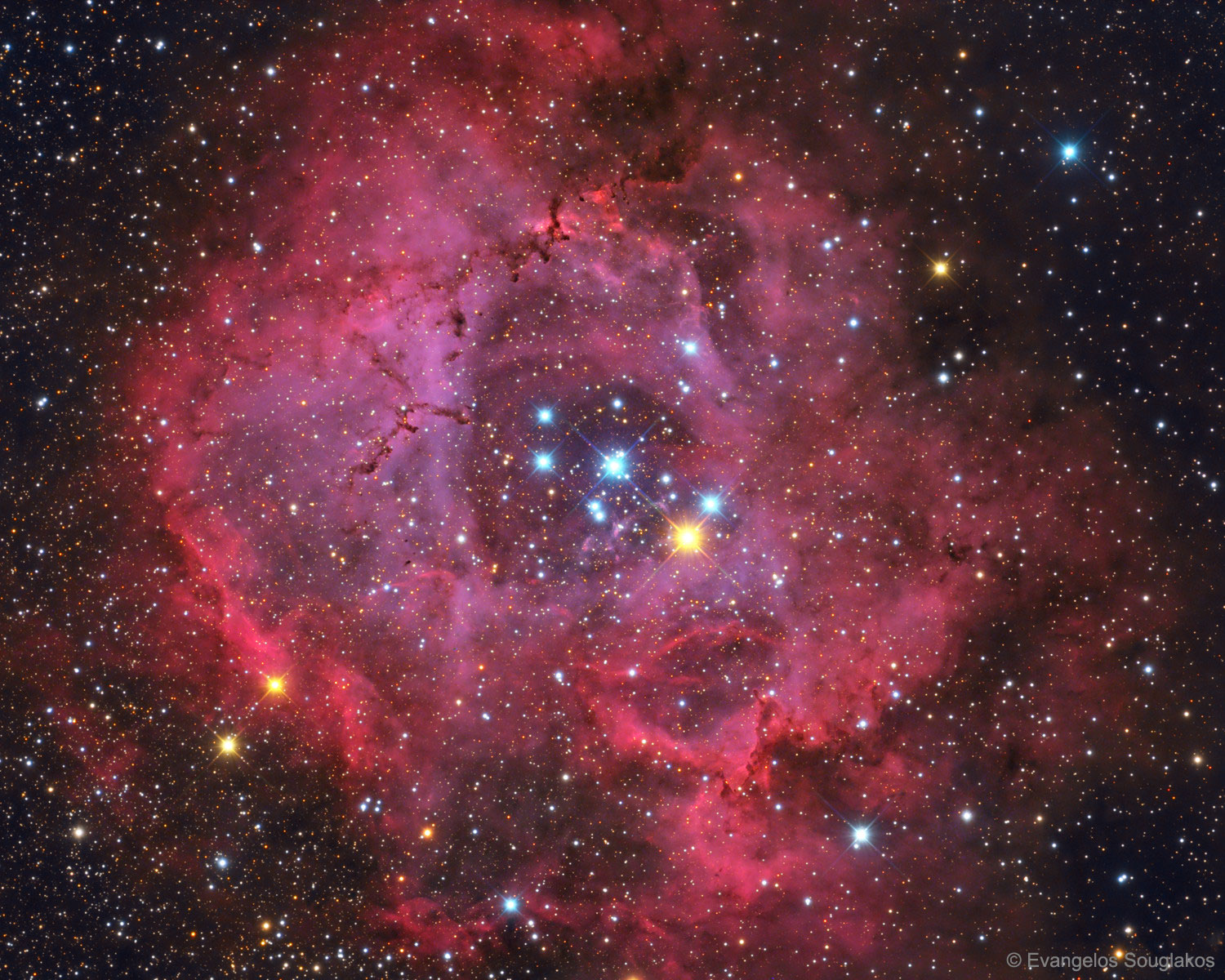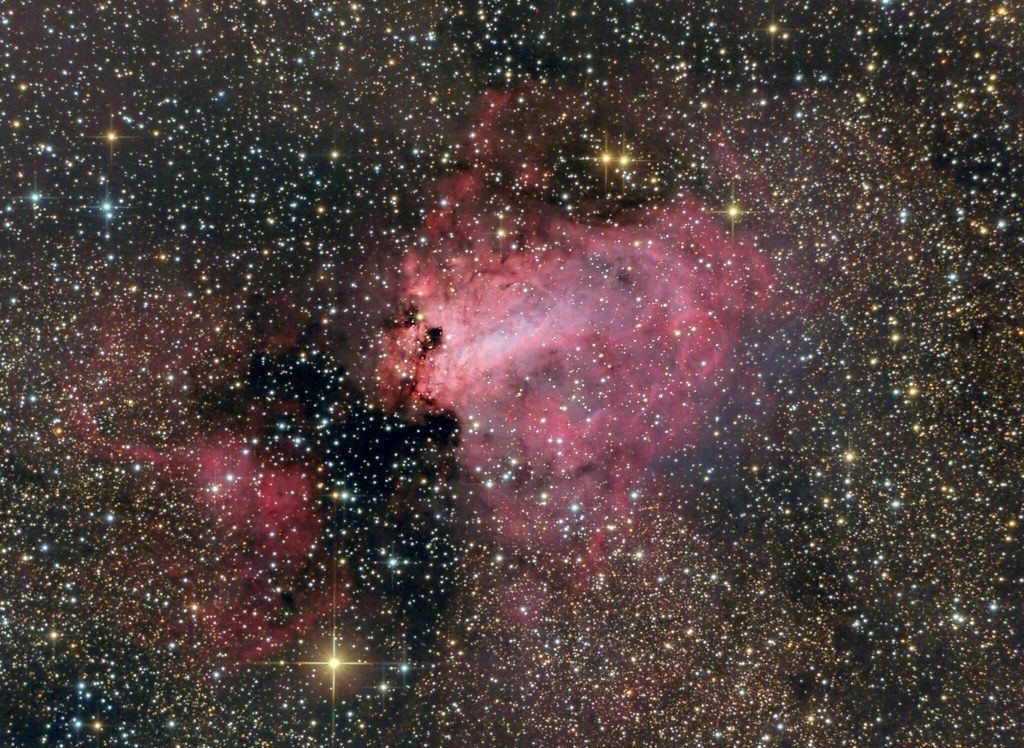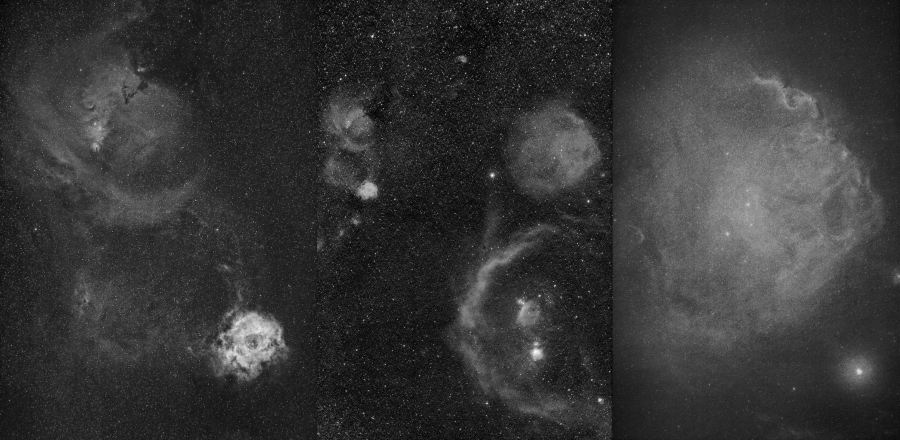The Rosette Nebula. Photo: Evangelos Souglakis.
Comparison between the Rosette and the Orion nebula.
Photo: AstroBackyard.
The Rosette Nebula represents an evolutionary stage of a massive cluster and its nebula, where none of the stars have turned into a red giant yet, but the stars have blown a very obvious central hole in the nebula and generally begun to disperse it.
Look at the picture at right. You should be able to spot the Orion Nebula quite easily. It is located almost dead center, and it looks like a small bright pinkish-white patch. The Rosette Nebula is so much fainter, because the ionizing cluster, NGC 2244, is old enough to have blown away much of its natal nebula. The center of the nebula is completely evacuated, leaving an obvious cavity there. But NGC 2244 is not old enough for any of its massive stars to have turned into red giants, and the obvious orange star near the center of the image at left is a foreground object.
Wikipedia wrote:
NGC 2244 (also known as Caldwell 50) is an open cluster in the Rosette Nebula, which is located in the constellation Monoceros. This cluster has several O-type stars, super hot stars that generate large amounts of radiation and stellar wind.
The age of this cluster has been estimated to be less than 5 million years. The brightest star in the cluster is 12 Monocerotis, a foreground K-class giant. The two brightest members of the cluster are HD 46223 of spectral class O4V, 400,000 times brighter than the Sun, and approximately 50 times more massive
It is interesting to compare the Rosette nebula and cluster NGC 2244 with slightly similar objects of different ages.
M17, the Omega Nebula. Photo: ESO.
The Omega Nebula. Photo: Michael Kalika.
M17, the Omega Nebula, is much younger than the Rosette Nebula.
Wikipedia wrote about the Omega Nebula:
It is considered one of the brightest and most massive star-forming regions of our galaxy.[3] Its local geometry is similar to the Orion Nebula except that it is viewed edge-on rather than face-on.[5]
The open cluster NGC 6618 lies embedded in the nebulosity and causes the gases of the nebula to shine due to radiation from these hot, young stars; however, the actual number of stars in the nebula is much higher - up to 800, 100 of spectral type earlier than B9, and 9 of spectral type O,[citation needed] plus over a thousand stars in formation on its outer regions. It is also one of the youngest clusters known, with an age of just 1 million years.
I once read that the open cluster in M17, NGC 6618, has caused a "
champagne flow" of gas out of the Omega Nebula. You know, like when the champagne cork pops and the champagne just bursts out like a jet.
That is why I like the picture of M17 at left. You can really see the champagne flow, the broad white jet which has burst out of the nebula, and the surrounding gas forming red Hα shock fronts light years from where the jet first hit the interstellar medium.
The reason why I like the picture of M17 above right is because it underscores the thick black cloud of gas and dust from which the cluster NGC 6618 formed. The cluster is still hidden from us in visual light. It is obvious that the Omega Nebula is very young, because it still contains so much gas and dust that the central cluster is completely hidden from our point of view. All the powerful O-type stars in this nebula have not yet had time to blow most of the gas away, in spite of the violent champagne flow.
The Double Cluster in Perseus.
Photo: Brook Mar Observatory.
Finally, take a look at the Double Cluster of Perseus. They are two extremely massive and impressive young clusters, but they are older than the clusters of both the Omega Nebula and the Rosette Nebula.
Wikipedia wrote:
NGC 869 has a mass of 3700 solar masses and NGC 884 weighs in at 2800 solar masses; however, later research has shown both clusters are surrounded with a very extensive halo of stars, with a total mass for the complex of at least 20,000 solar masses.[3] Based on their individual stars, the clusters are relatively young, both 12.8 million years old.[4] In comparison, the Pleiades have an estimated age ranging from 75 million years to 150 million years.
There are more than 300 blue-white super-giant stars in each of the clusters. The clusters are also blueshifted, with NGC 869 approaching Earth at a speed of 39 km/s (24 mi/s) and NGC 884 approaching at a similar speed of 38 km/s (24 mi/s).[5] Their hottest main sequence stars are of spectral type B0. NGC 884 includes five prominent red supergiant stars, all variable and all around 8th magnitude: RS Persei, AD Persei, FZ Persei, V403 Persei, and V439 Persei.
You can very easily spot the red supergiants in NGC 884 in the Double Cluster. These are real red supergiants, not modest K-type giants like the orange foreground star in front of the Rosette Nebula.
But the dead giveaway that these clusters are past their adolescence is that their natal clouds are completely gone. The powerful massive stars of the Double Cluster have completely dispersed the gas clouds from which these mighty clusters were born. Now they are "naked" in space.
Ann
 A Cosmic Rose: The Rosette Nebula in Monoceros
A Cosmic Rose: The Rosette Nebula in Monoceros




